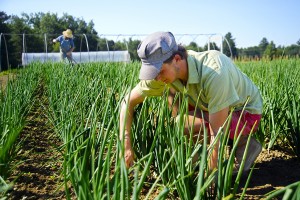Exploring Rogers Farm
 As this past spring semester came to a close, researchers and students at Rogers Farm — the sustainable agriculture research facility of the College of Natural Sciences, Forestry, and Agriculture — were gearing up for another busy summer.
As this past spring semester came to a close, researchers and students at Rogers Farm — the sustainable agriculture research facility of the College of Natural Sciences, Forestry, and Agriculture — were gearing up for another busy summer.
July 16, the Sustainable Agriculture Field Day was held at Rogers Farm, which featured demonstrations by graduate students, researchers and faculty. Topics included cultivation efficacy, small grain customization, producing and certifying small grain seed, weed management and malt barley varieties for new craft brewing markets.
Rogers Farm, located 3.5 miles from the University of Maine, is one of two locations that make up the college’s J.F. Witter Teaching and Research Center.
As a mixed-usage research site, crops grown on the farm include silage corn, sweet corn, potatoes, dried beans, small grains and mixed vegetables. The farm provides land for the Penobscot County Cooperative Extension Master Gardeners Demonstration Garden and the Black Bear Food Guild, the university’s student-run community-supported agriculture program.
The farm, purchased in 1947, is used for a wide range of sustainable agriculture research, UMaine Extension and teaching projects year-round.
Barley to Beer
In recent years, Ellen Mallory, sustainable agriculture extension specialist and associate professor in plant, soils, and environmental science, has led a large research and outreach program focused on grains for local food, beverage and feed markets.
Her current projects include evaluation of barley varieties for craft brewing markets and Danish wheat and rye varieties for bread flour, optimizing nitrogen management for fall-planted grains and forage or feed production with field peas. Her research group also is working with Maine entrepreneur Alex Bennett to grow cereals for a natural drinking straw, a project called “Straw Straws.”
Optimizing Potato Research
John Jemison, UMaine Extension specialist, recently completed a multiyear project evaluating double crop forage systems and winter canola. Jemison’s project is in collaboration with Greg Porter, professor of agronomy and director of UMaine’s potato breeding program, to provide a central Maine location for evaluating potato varieties.
Harnessing the Power of the Sun
Eric Gallandt, professor of weed ecology and management, leads various research projects at the farm. His research focuses on dynamics and management of annual weeds in organic farming systems.
In a new series of field experiments, motivated by questions from Maine farmers, Gallandt and Ph.D. student Sonja Birthisel are studying soil solarization as a weed management practice. Solarization is the practice of controlling agricultural pests by heating the soil using clear plastic mulch that harnesses solar energy.
This strategy is an established practice in arid climates, where ambient temperatures and solar radiation are often lethal to weed seeds and soil-borne pathogens. In temperate environments such as Maine, soil solarization is not widely used, but early results indicate it can dramatically reduce weed pressure, creating a “stale seedbed” that is relatively free of weeds before seeding vegetable crops. Birthisel and Gallandt were surprised by the early field results.
“When we removed the plastic and found no weeds, we really wondered what was going on,” says Gallandt. “We expected the warmer soil to encourage a large flush of weeds that could be killed by tillage before planting.”
Later, after retrieving temperature data loggers from the soil, they found soil temperatures at a 4-inch depth were as high as 115 F, conditions lethal to many weed seeds.
Organic Weed Management
Ph.D. student Bryan Brown is working on a project aimed at quantifying multiple dimensions of the performance of four common and fundamentally different weed management strategies to help growers choose a strategy that best fits their production goals. Brown was awarded $13,147 from the Northeast Sustainable Agriculture Research and Education Association to support this project.
The researchers believe successful weed management may be achieved by: intensive, repeated cultivation during the “critical weed-free period” of the crop; comprehensive seed-focused management with a goal of zero seed rain; weed prevention through plastic mulch; or weed prevention through organic mulch.
In field experiments comparing these weed management systems, researchers are characterizing both short- and long-term effects, looking at how each system affects soil quality, the weed seedbank and profitability over time.
“We were quite surprised last year to find that our longer-term zero seed rain and mulch-based strategies were also the most profitable,” says Brown.
The researchers seek to understand factors that motivate farmers to adopt these contrasting weed management strategies and to help growers determine the optimum weed control strategy based on resources and management goals.
Rare Weeds in Northern New England
In a changing climate, rare species are coming into the spotlight. Climate change could lead to local extinctions, or allow for increased abundance and potential new invasions by rare species.
In a study led by Gallandt, researchers are determining the abundance and distribution of agronomic weeds. Researchers collected soil samples from 77 farms in Maine, New Hampshire and Vermont. The collected seeds were germinated in a greenhouse and the seedlings were identified to species.
They found in Maine, New Hampshire and Vermont that the ratios of rare weed species to total weed species identified were 67:94, 20:64, and 24:67, respectively.
This study is a first attempt to identify rare agronomic weeds in Maine’s environment. Further work integrating naturalistic approaches with climate projections could further help to predict potential invasions and identify conservation targets in a changing climate.
In July and August, Birthisel and Brown are revisiting Maine farms to survey fields and talk with farmers to identify rare or unusual weeds that could present a problem in the future.
